brake KIA Soul 2013 1.G Owner's Manual
[x] Cancel search | Manufacturer: KIA, Model Year: 2013, Model line: Soul, Model: KIA Soul 2013 1.GPages: 393, PDF Size: 8.76 MB
Page 5 of 393
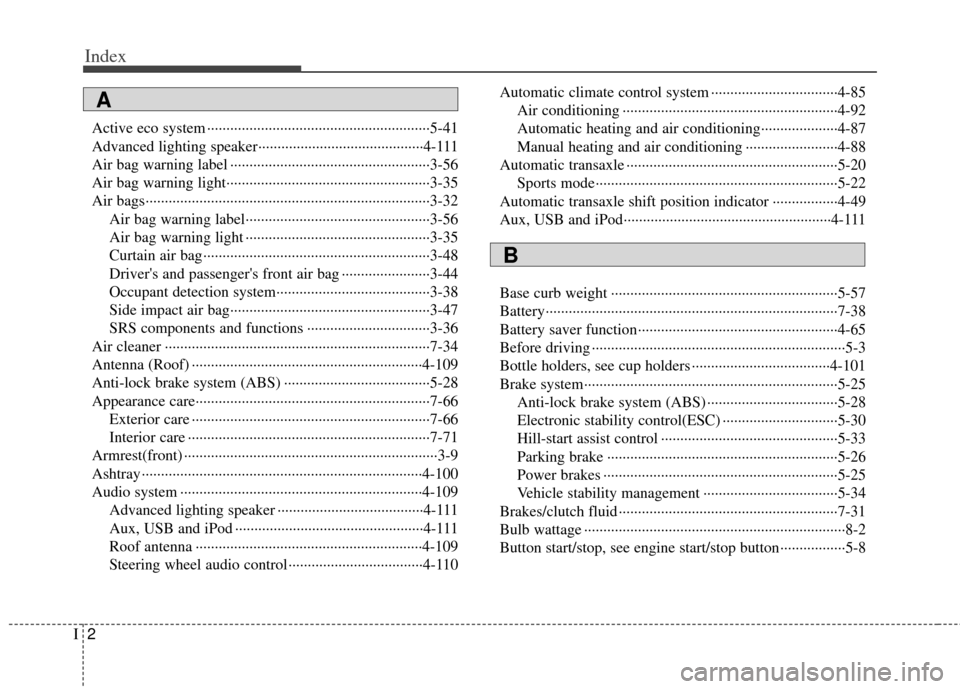
Index
2I
Active eco system ··················\
··················\
··················\
····5-41
Advanced lighting speaker··················\
··················\
·······4-111
Air bag warning label ··················\
··················\
················3-56
Air bag warning light··················\
··················\
·················3-35\
Air bags··················\
··················\
··················\
··················\
··3-32Air bag warning label··················\
··················\
············3-56
Air bag warning light ··················\
··················\
············3-35
Curtain air bag··················\
··················\
··················\
·····3-48
Driver's and passenger's front air bag ··················\
·····3-44
Occupant detection system··················\
··················\
····3-38
Side impact air bag··················\
··················\
················3-47
SRS components and functions ··················\
··············3-36
Air cleaner ··················\
··················\
··················\
···············7-34
Antenna (Roof) ··················\
··················\
··················\
······4-109
Anti-lock brake system (ABS) ··················\
··················\
··5-28
Appearance care··················\
··················\
··················\
·······7-66 Exterior care ··················\
··················\
··················\
········7-66
Interior care ··················\
··················\
··················\
·········7-71
Armrest(front) ··················\
··················\
··················\
············3-9
Ashtray ··················\
··················\
··················\
··················\
·4-100
Audio system ··················\
··················\
··················\
·········4-109 Advanced lighting speaker ··················\
··················\
··4-111
Aux, USB and iPod ··················\
··················\
·············4-111
Roof antenna ··················\
··················\
··················\
·····4-109
Steering wheel audio control··················\
·················4-110 Automatic climate control system ··················\
···············4-85
Air conditioning ··················\
··················\
··················\
··4-92
Automatic heating and air conditioning··················\
··4-87
Manual heating and air conditioning ··················\
······4-88
Automatic transaxle ··················\
··················\
··················\
·5-20 Sports mode··················\
··················\
··················\
·········5-22
Automatic transaxle shift position indicator ·················4-49\
Aux, USB and iPod··················\
··················\
··················\
4-111
Base curb weight ··················\
··················\
··················\
·····5-57
Battery··················\
··················\
··················\
··················\
····7-38
Battery saver function··················\
··················\
················4-65
Before driving ··················\
··················\
··················\
············5-3
Bottle holders, see cup holders ··················\
··················\
4-101
Brake system··················\
··················\
··················\
············5-25 Anti-lock brake system (ABS) ··················\
················5-28
Electronic stability control(ESC) ··················\
············5-30
Hill-start assist control ··················\
··················\
··········5-33
Parking brake ··················\
··················\
··················\
······5-26
Power brakes ··················\
··················\
··················\
·······5-25
Vehicle stability management ··················\
·················5-34\
Brakes/clutch fluid ··················\
··················\
··················\
···7-31
Bulb wattage ··················\
··················\
··················\
··············8-2
Button start/stop, see engine start/stop button·················5-8
A
B
Page 7 of 393
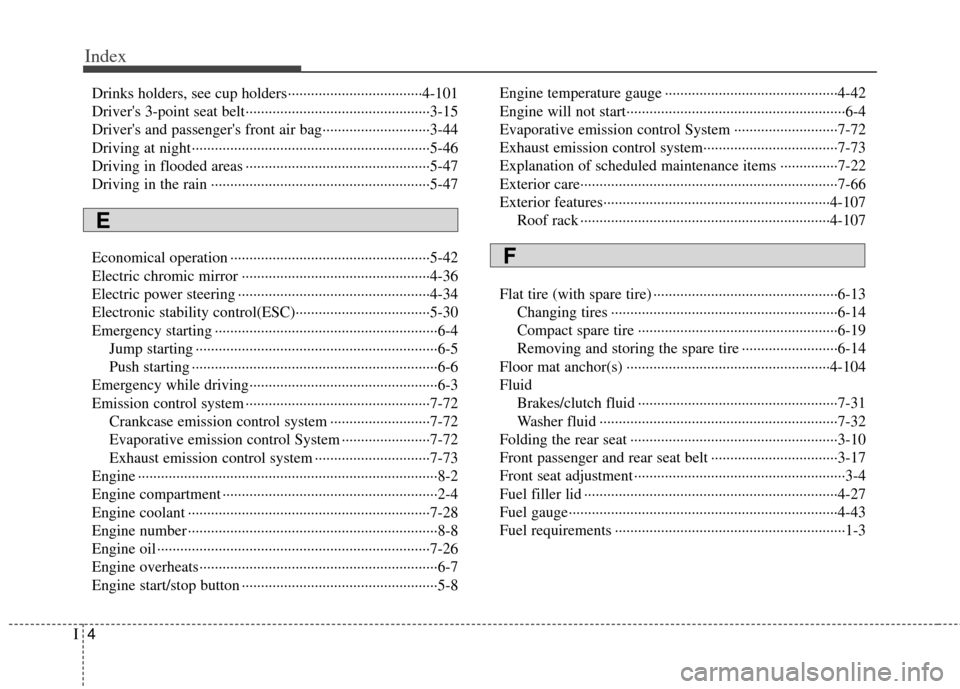
Index
4I
Drinks holders, see cup holders··················\
·················4-10\
1
Driver's 3-point seat belt··················\
··················\
············3-15
Driver's and passenger's front air bag··················\
··········3-44
Driving at night··················\
··················\
··················\
········5-46
Driving in flooded areas ··················\
··················\
············5-47
Driving in the rain ··················\
··················\
··················\
···5-47
Economical operation ··················\
··················\
················5-42
Electric chromic mirror ··················\
··················\
·············4-36
Electric power steering ··················\
··················\
··············4-34
Electronic stability control(ESC)··················\
·················5-30\
Emergency starting ··················\
··················\
··················\
····6-4Jump starting ··················\
··················\
··················\
·········6-5
Push starting ··················\
··················\
··················\
··········6-6
Emergency while driving··················\
··················\
·············6-3
Emission control system ··················\
··················\
············7-72 Crankcase emission control system ··················\
········7-72
Evaporative emission control System ··················\
·····7-72
Exhaust emission control system ··················\
············7-73
Engine ··················\
··················\
··················\
··················\
······8-2
Engine compartment ··················\
··················\
··················\
··2-4
Engine coolant ··················\
··················\
··················\
·········7-28
Engine number ··················\
··················\
··················\
···········8-8
Engine oil ··················\
··················\
··················\
·················7-26\
Engine overheats··················\
··················\
··················\
········6-7
Engine start/stop button ··················\
··················\
···············5-8 Engine temperature gauge ··················\
··················\
·········4-42
Engine will not start··················\
··················\
··················\
···6-4
Evaporative emission control System ··················\
·········7-72
Exhaust emission control system··················\
·················7-73\
Explanation of scheduled maintenance items ···············7-22
Exterior care··················\
··················\
··················\
·············7-66
Exterior features··················\
··················\
··················\
·····4-107
Roof rack ··················\
··················\
··················\
···········4-107
Flat tire (with spare tire) ··················\
··················\
············6-13 Changing tires ··················\
··················\
··················\
·····6-14
Compact spare tire ··················\
··················\
················6-19
Removing and storing the spare tire ··················\
·······6-14
Floor mat anchor(s) ··················\
··················\
·················4-10\
4
Fluid Brakes/clutch fluid ··················\
··················\
················7-31
Washer fluid ··················\
··················\
··················\
········7-32
Folding the rear seat ··················\
··················\
··················\
3-10
Front passenger and rear seat belt ··················\
···············3-17
Front seat adjustment ··················\
··················\
··················\
·3-4
Fuel filler lid ··················\
··················\
··················\
············4-27
Fuel gauge··················\
··················\
··················\
················4-43
Fuel requirements ··················\
··················\
··················\
······1-3
E
F
Page 10 of 393

I7
Index
Mirrors ··················\
··················\
··················\
··················\
···4-36Day/night rearview mirror ··················\
··················\
····4-36
Electric chromic mirror ··················\
··················\
·········4-36
Inside rearview mirror··················\
··················\
···········4-36
Outside rearview mirror ··················\
··················\
········4-37
Multi box ··················\
··················\
··················\
·················4-99\
Occupant detection system ··················\
··················\
········3-38
Odometer ··················\
··················\
··················\
·················4-43\
Oil (Engine) ··················\
··················\
··················\
·············7-26
Outside rearview mirror··················\
··················\
·············4-37
Outside temperature ··················\
··················\
··················\
·4-48
Overheats ··················\
··················\
··················\
··················\
·6-7
Owner maintenance ··················\
··················\
··················\
···7-6
Parking brake ··················\
··················\
··················\
···········5-26
Parking brake ··················\
··················\
··················\
···········7-33
Power brakes··················\
··················\
··················\
············5-25
Power outlet ··················\
··················\
··················\
···········4-102
Power window lock button ··················\
··················\
········4-24
Pre-tensioner seat belt··················\
··················\
················3-19
Push starting··················\
··················\
··················\
···············6-6 Rear seat··················\
··················\
··················\
··················\
·3-10
Rearview camera ··················\
··················\
··················\
·····4-63
Recommended cold tire inflation pressures ··················\
7-41
Recommended lubricants and capacities ··················\
·······8-4
Recommended SAE viscosity number··················\
······8-6
Refrigerant label ··················\
··················\
··················\
········8-8
Remote keyless entry ··················\
··················\
··················\
·4-6
Road warning ··················\
··················\
··················\
·············6-2
Rocking the vehicle ··················\
··················\
··················\
·5-45
Roof antenna ··················\
··················\
··················\
··········4-109
Roof rack ··················\
··················\
··················\
···············4-107
Scheduled maintenance service ··················\
··················\
···7-8 Maintenance under severe usage conditions ·············7-21
Normal maintenance schedule ··················\
··················\
7-9
Seat belt warning ··················\
··················\
··················\
·····3-15
Seat belts ··················\
··················\
··················\
··················\
3-14 Hight adjustment ··················\
··················\
··················\
·3-16
Pre-tensioner seat belt ··················\
··················\
···········3-19
Seat belt - Driver's 3-point system ··················\
··········3-15
Seat belt warning··················\
··················\
··················\
·3-15
Seat belts - Front passenger and rear seat ·················3-17\
Seat warmer ··················\
··················\
··················\
···············3-8
Seatback pocket ··················\
··················\
··················\
·······3-10
O
P
R
S
Page 18 of 393
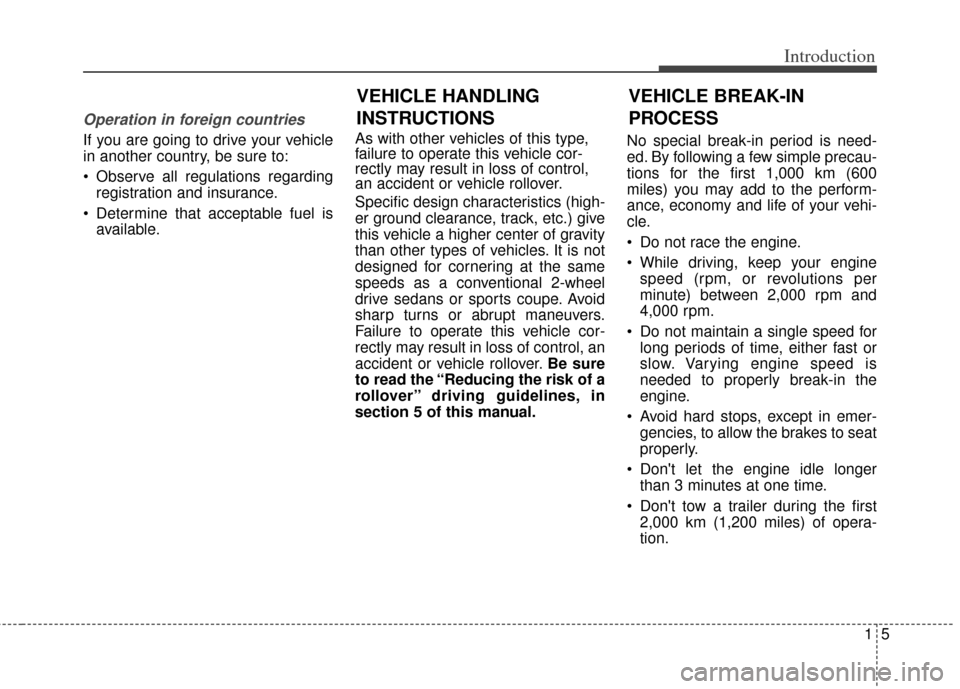
15
Introduction
Operation in foreign countries
If you are going to drive your vehicle
in another country, be sure to:
Observe all regulations regardingregistration and insurance.
Determine that acceptable fuel is available. As with other vehicles of this type,
failure to operate this vehicle cor-
rectly may result in loss of control,
an accident or vehicle rollover.
Specific design characteristics (high-
er ground clearance, track, etc.) give
this vehicle a higher center of gravity
than other types of vehicles. It is not
designed for cornering at the same
speeds as a conventional 2-wheel
drive sedans or sports coupe. Avoid
sharp turns or abrupt maneuvers.
Failure to operate this vehicle cor-
rectly may result in loss of control, an
accident or vehicle rollover.
Be sure
to read the “Reducing the risk of a
rollover” driving guidelines, in
section 5 of this manual. No special break-in period is need-
ed. By following a few simple precau-
tions for the first 1,000 km (600
miles) you may add to the perform-
ance, economy and life of your vehi-
cle.
Do not race the engine.
While driving, keep your engine
speed (rpm, or revolutions per
minute) between 2,000 rpm and
4,000 rpm.
Do not maintain a single speed for long periods of time, either fast or
slow. Varying engine speed is
needed to properly break-in the
engine.
Avoid hard stops, except in emer- gencies, to allow the brakes to seat
properly.
Don't let the engine idle longer than 3 minutes at one time.
Don't tow a trailer during the first 2,000 km (1,200 miles) of opera-
tion.
VEHICLE BREAK-IN
PROCESS
VEHICLE HANDLING
INSTRUCTIONS
Page 19 of 393
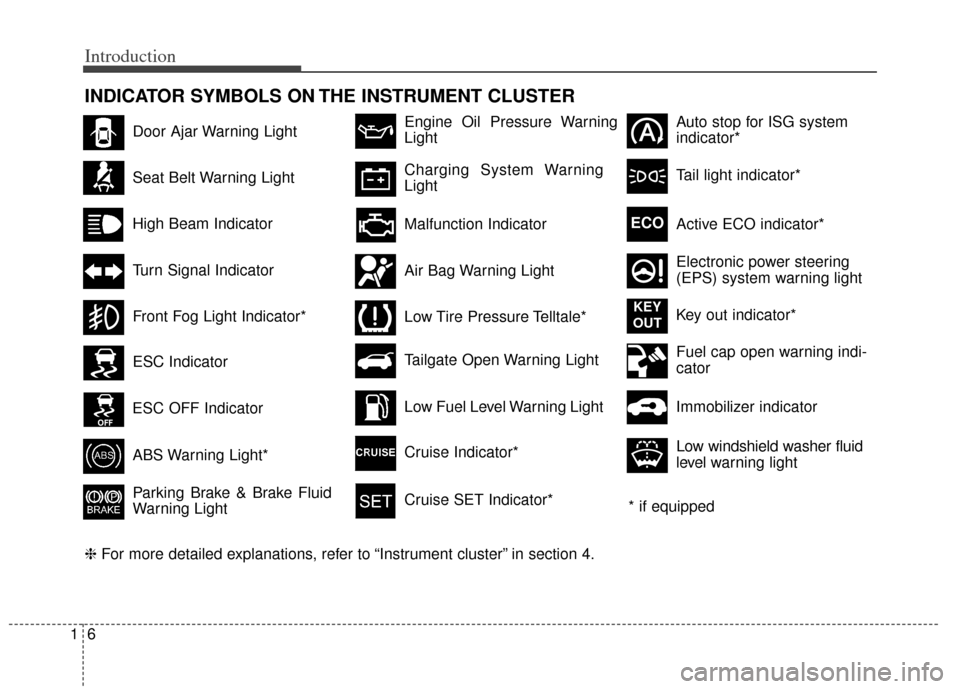
Introduction
61
INDICATOR SYMBOLS ON THE INSTRUMENT CLUSTER
Seat Belt Warning Light
High Beam Indicator
Turn Signal Indicator
ABS Warning Light*
Parking Brake & Brake Fluid
Warning Light
Malfunction Indicator
Low Fuel Level Warning Light Tailgate Open Warning Light
❈ For more detailed explanations, refer to “Instrument cluster” in section 4.
Charging System Warning
Light
Door Ajar Warning Light
Front Fog Light Indicator*
Engine Oil Pressure Warning
Light
Air Bag Warning Light
Low Tire Pressure Telltale*
Cruise Indicator*
Cruise SET Indicator*
ESC Indicator
ESC OFF Indicator
Tail light indicator*
Electronic power steering
(EPS) system warning light
Auto stop for ISG system
indicator*
Active ECO indicator*
ECO
Key out indicator*
KEY
OUT
* if equipped
Fuel cap open warning indi-
cator
Low windshield washer fluid
level warning light Immobilizer indicator
Page 22 of 393
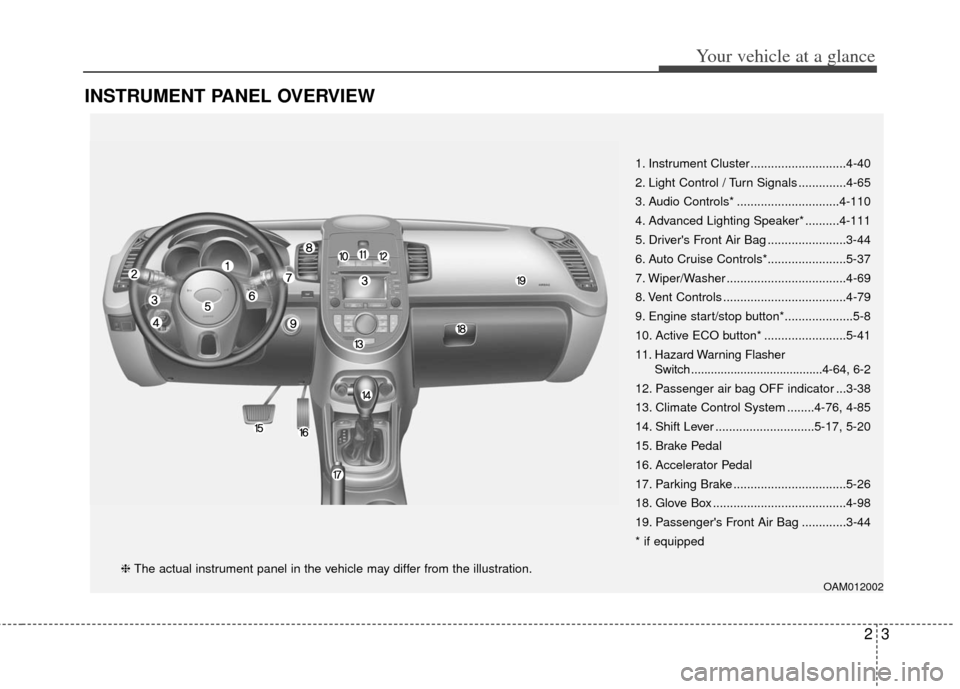
23
Your vehicle at a glance
INSTRUMENT PANEL OVERVIEW
1. Instrument Cluster ............................4-40
2. Light Control / Turn Signals ..............4-65
3. Audio Controls* ..............................4-110
4. Advanced Lighting Speaker* ..........4-111
5. Driver's Front Air Bag .......................3-44
6. Auto Cruise Controls*.......................5-37
7. Wiper/Washer ...................................4-69
8. Vent Controls ....................................4-79
9. Engine start/stop button*....................5-8
10. Active ECO button* ........................5-41
11. Hazard Warning Flasher Switch ........................................4-64, 6-2
12. Passenger air bag OFF indicator ...3-38
13. Climate Control System ........4-76, 4-85
14. Shift Lever .............................5-17, 5-20
15. Brake Pedal
16. Accelerator Pedal
17. Parking Brake .................................5-26
18. Glove Box .......................................4-98
19. Passenger's Front Air Bag .............3-44
* if equipped
OAM012002
❈ The actual instrument panel in the vehicle may differ from the illustration.
Page 23 of 393
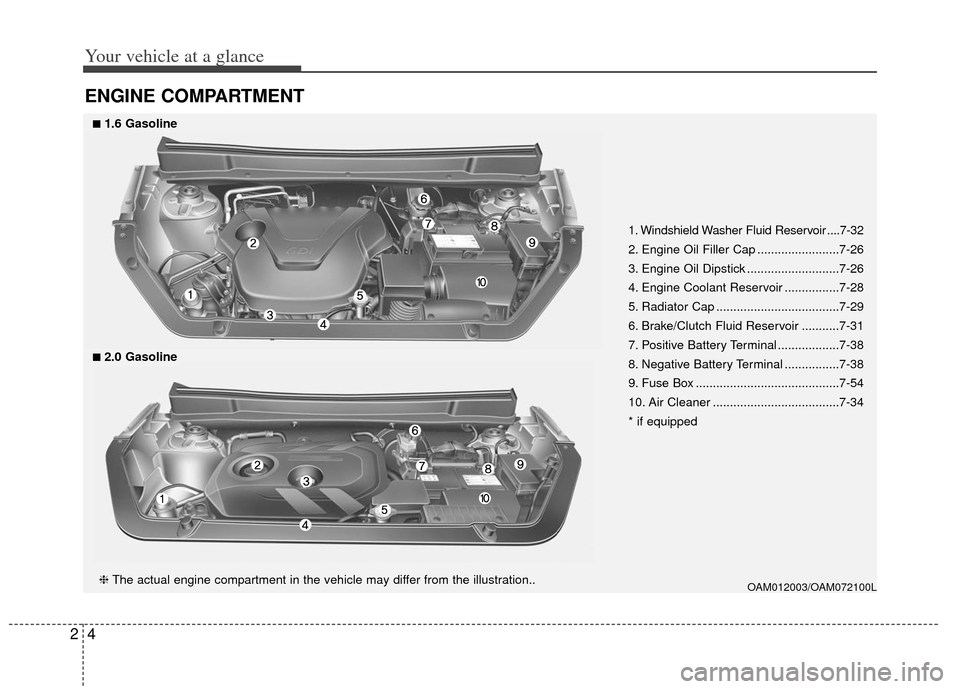
Your vehicle at a glance
42
ENGINE COMPARTMENT
OAM012003/OAM072100L
1. Windshield Washer Fluid Reservoir ....7-32
2. Engine Oil Filler Cap ........................7-26
3. Engine Oil Dipstick ...........................7-26
4. Engine Coolant Reservoir ................7-28
5. Radiator Cap ....................................7-29
6. Brake/Clutch Fluid Reservoir ...........7-31
7. Positive Battery Terminal ..................7-38
8. Negative Battery Terminal ................7-38
9. Fuse Box ..........................................7-54
10. Air Cleaner .....................................7-34
* if equipped
❈The actual engine compartment in the vehicle may differ from the illustration..
■2.0 Gasoline
■1.6 Gasoline
Page 77 of 393
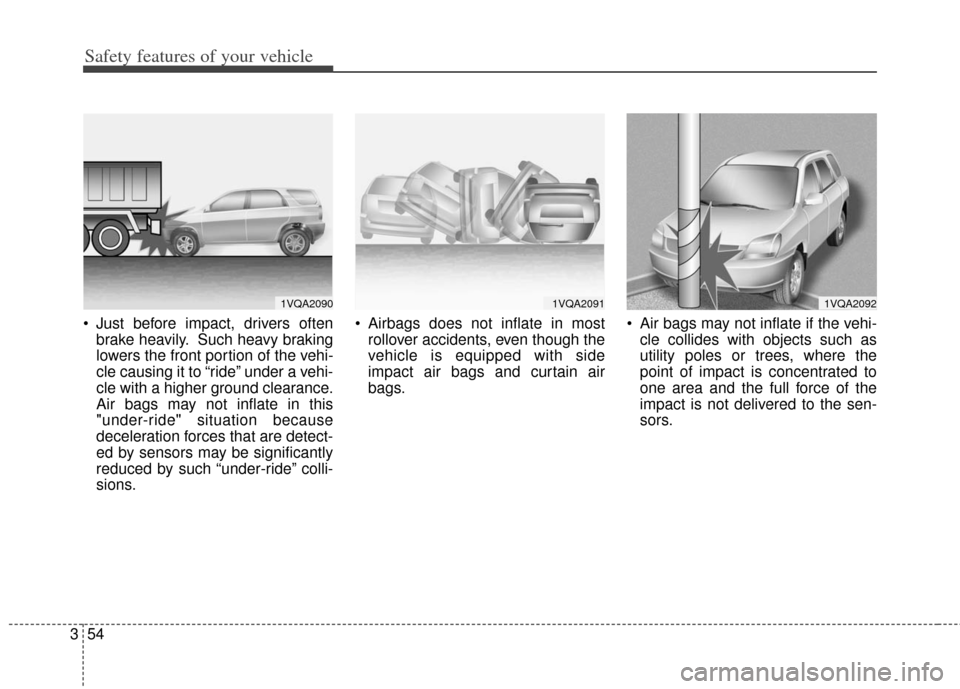
Safety features of your vehicle
54
3
Just before impact, drivers often
brake heavily. Such heavy braking
lowers the front portion of the vehi-
cle causing it to “ride” under a vehi-
cle with a higher ground clearance.
Air bags may not inflate in this
"under-ride" situation because
deceleration forces that are detect-
ed by sensors may be significantly
reduced by such “under-ride” colli-
sions. Airbags does not inflate in most
rollover accidents, even though the
vehicle is equipped with side
impact air bags and curtain air
bags. Air bags may not inflate if the vehi-
cle collides with objects such as
utility poles or trees, where the
point of impact is concentrated to
one area and the full force of the
impact is not delivered to the sen-
sors.
1VQA20901VQA20911VQA2092
Page 95 of 393
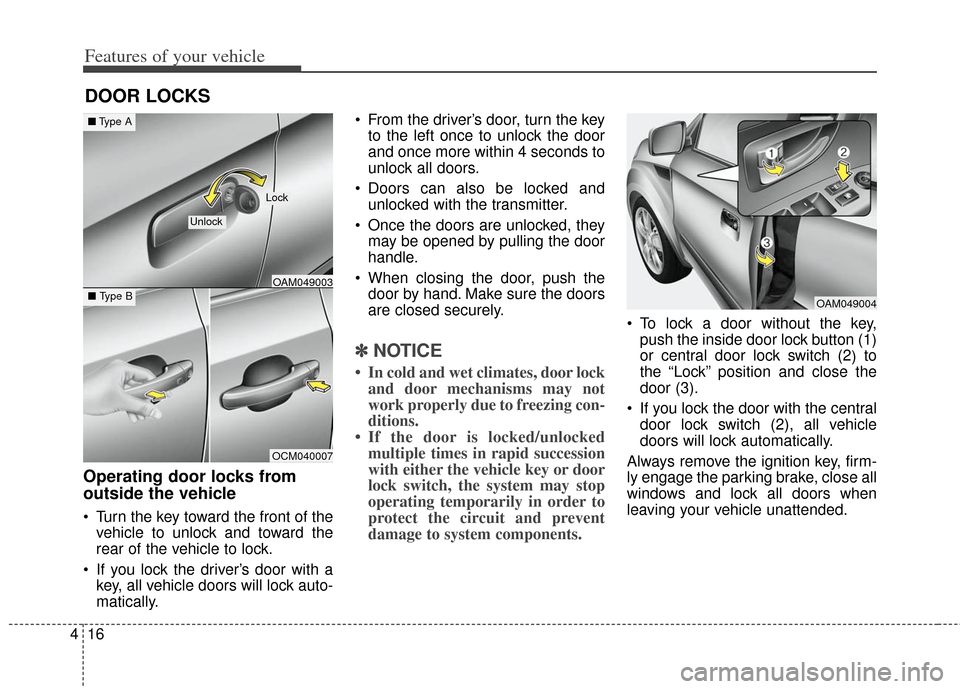
Features of your vehicle
16
4
Operating door locks from
outside the vehicle
Turn the key toward the front of the
vehicle to unlock and toward the
rear of the vehicle to lock.
If you lock the driver’s door with a key, all vehicle doors will lock auto-
matically. From the driver’s door, turn the key
to the left once to unlock the door
and once more within 4 seconds to
unlock all doors.
Doors can also be locked and unlocked with the transmitter.
Once the doors are unlocked, they may be opened by pulling the door
handle.
When closing the door, push the door by hand. Make sure the doors
are closed securely.
✽ ✽ NOTICE
• In cold and wet climates, door lock
and door mechanisms may not
work properly due to freezing con-
ditions.
• If the door is locked/unlocked multiple times in rapid succession
with either the vehicle key or door
lock switch, the system may stop
operating temporarily in order to
protect the circuit and prevent
damage to system components.
To lock a door without the key,
push the inside door lock button (1)
or central door lock switch (2 ) to
the “Lock” position and close the
door (3).
If you lock the door with the central door lock switch (2), all vehicle
doors will lock automatically.
Always remove the ignition key, firm-
ly engage the parking brake, close all
windows and lock all doors when
leaving your vehicle unattended.
DOOR LOCKS
OAM049004
OCM040007
■ Type BOAM049003
■Type A
Unlock
Lock
Page 104 of 393
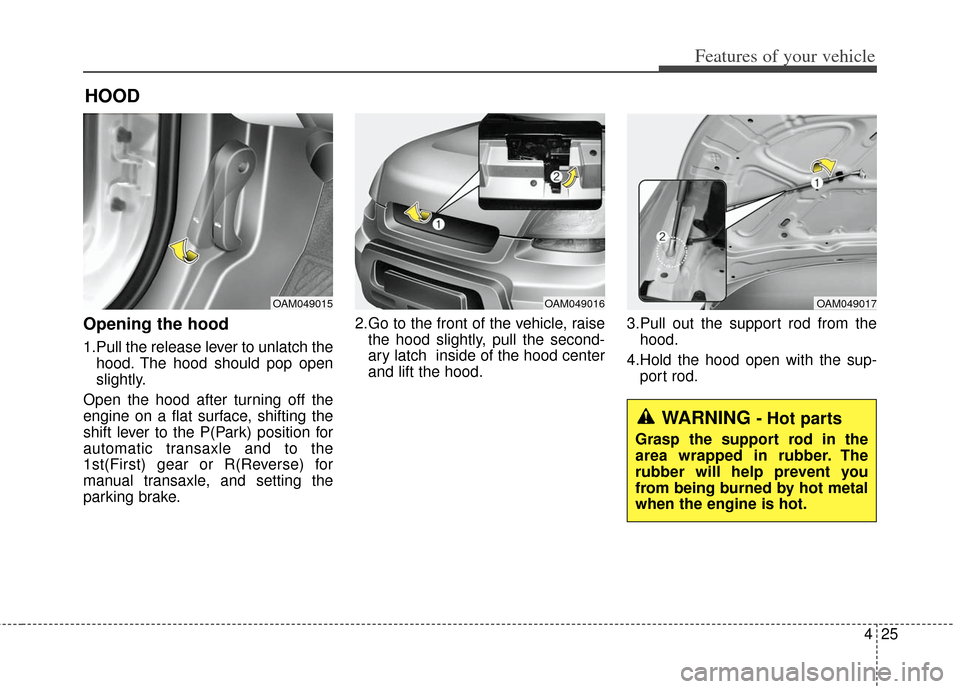
425
Features of your vehicle
Opening the hood
1.Pull the release lever to unlatch thehood. The hood should pop open
slightly.
Open the hood after turning off the
engine on a flat surface, shifting the
shift lever to the P(Park) position for
automatic transaxle and to the
1st(First) gear or R(Reverse) for
manual transaxle, and setting the
parking brake. 2.Go to the front of the vehicle, raise
the hood slightly, pull the second-
ary latch inside of the hood center
and lift the hood. 3.Pull out the support rod from the
hood.
4.Hold the hood open with the sup- port rod.
HOOD
OAM049015OAM049016OAM049017
WARNING - Hot parts
Grasp the support rod in the
area wrapped in rubber. The
rubber will help prevent you
from being burned by hot metal
when the engine is hot.